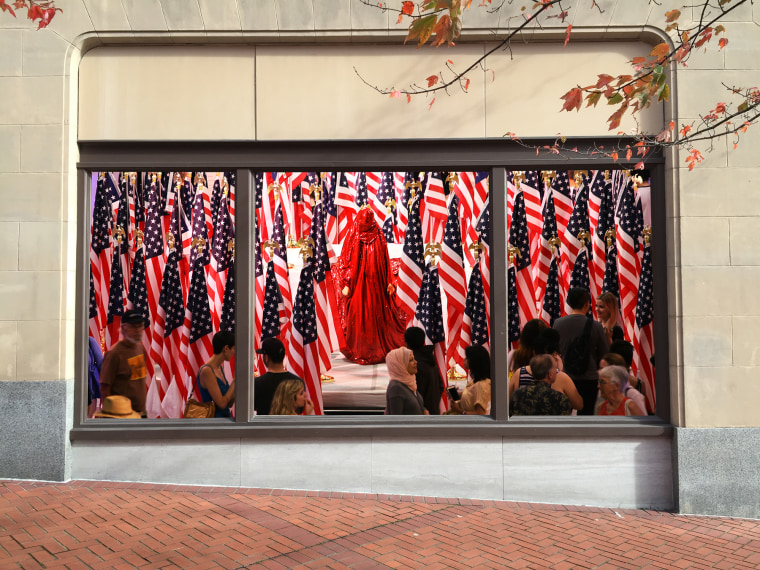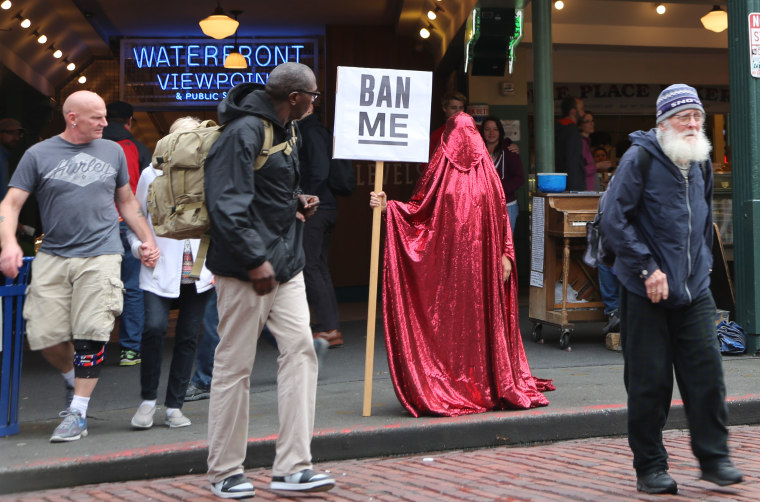Lately, Anida Yoeu Ali has spent much of her time in public wearing a bright red, sequined, veiled “chador,” a Muslim headdress that envelops her body from head to toe.
The sparkling garment intensifies her visibility, making her impossible to ignore.
“The Red Chador asks the question, ‘what do you fear?’ It provokes ideas of otherness,” Ali told NBC News.
“I have seen what my work can do in calming people down, and showing a humanized version of who I am. ... I believe in art’s power to be transformative.”
Ali, a first generation Muslim Khmer woman born in Cambodia and raised in Chicago, is an artist, professor, and cultural agitator whose work explores the artistic, spiritual, and political intersections of transnational identity.
Her current work, “Red Chador,” investigates attitudes toward Muslims, and Islamophobia. Initially commissioned as a performance piece by the Palais de Tokyo Museum in Paris in April of 2015, Ali created the "Red Chador” around the same period when the city was still recovering from the Charlie Hebdo attacks.
“I was thinking a lot about the resonance of French colonial history in Southeast Asia, particularly Cambodia,” Ali said. “I was also reflecting on the way Muslims were being portrayed in the media , accompanied by words such as ‘beheading’ and ‘terrorism.’ It was interesting to see a kind of savagery attached to Islam. I also thought about the conversations around burqua bans in France. I knew I wanted to put forth a piece that expressed my identity as a South East Asian Muslim.”

Her first performance in Paris involved a staged “beheading” of a baguette, a symbol of French life and culture, Ali noted.
Inviting the public to ”save” the baguette from being held hostage, Ali asked the audience to perform several actions in exchange for the baguette’s safety. For example, she once asked an audience of students to find the flags of all the countries France has colonized. Not knowing where to acquire the flags, the students proposed that they draw the flags for her instead. She accepted, and the students succeeded in rescuing the baguette.
“I saw people’s humanity coming out,” Ali said. “They tried everything they could to sway the Red Chador to spare the baguette. They were getting dramatic and upset; they understood what it symbolized. “
Since Paris, Ali has brought "Red Chador” to the United States, where has she received polarized public reactions, from the violent to the benevolent. When taking the work to Hartford, Conneticut, Ali said she was greeted with ”an American arrogance and hostility” that she wasn’t prepared for.
“I saw people visibly exhibiting fear and trepidation — they were literally shaking,” she said. “A lot of profanity was thrown at me from white men who didn’t know what she symbolized. I didn’t say a word. I was just her. Her very existence was the problem: a clearly identifiable Muslim woman.”
“Red Chador” has also been exhibited in The Smithsonian, where she stood at the center of a platform surrounded by American flags. The performance juxtaposed ideas of patriotism with a highly visible Muslim woman, Ali said. Despite apprehension from the curators, the performance was met by positive responses from veterans.
“Two veterans in plain clothes told the museum director what a powerful piece it was, and that it represented why they fought for the country. It was powerful,” Ali said.
Still, Ali’s performances have sometimes been met with violence, causing her to break out of character to get to safety, she said. But in its best moments, like when Ali took “Red Chador” out for a walk in Seattle after the November elections, it also revealed a deep sense of humanity and solidarity.
Taking to the streets with a sign that said “Ban Me” on one side and “I am a Muslim” on the other, Ali was greeted with acceptance and empathy.
“It was deeply cathartic,” she said. “People were crying and supporting me. They whispered ‘I’m sorry’ and ‘I am a Muslim too.’”
“The Red Chador asks the question, ‘what do you fear?’ It provokes ideas of otherness.”
The "Red Chador" has since traveled to places including Art Central Hong Kong, the Asian Art Museum in San Francisco, and the Spaceworks Gallery in Tacoma, Washington. This year, Ali plans to bring the project to London, Sydney, and back to her home country, Cambodia. But while she’s traveled internationally, there is still one place she’d really like to bring her: the rural United States.
“My work is all about taking to people; people who don’t normally go to cultural institutions,” she said. “I think [it’s] important to open up these conversations with rural communities, those who are removed from those of us in the liberal bubbles. I would like to be part of opening up that dialogue.”
“I have seen what my work can do in calming people down, and showing a humanized version of who I am,” she added. “I let participants take off my veil to see that I am a human being under there. I believe in art’s power to be transformative.”
Follow NBC Asian America on Facebook, Twitter, Instagram and Tumblr.
